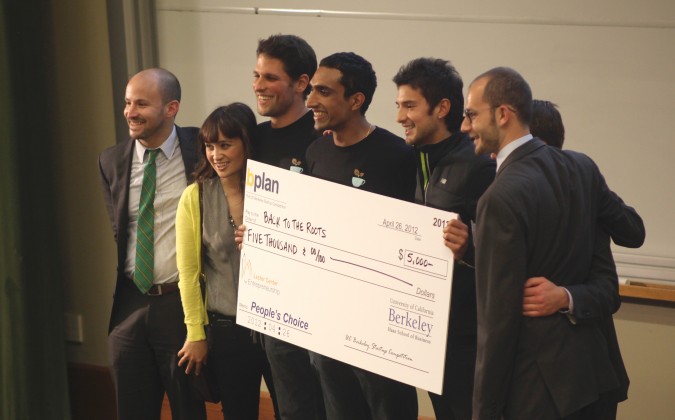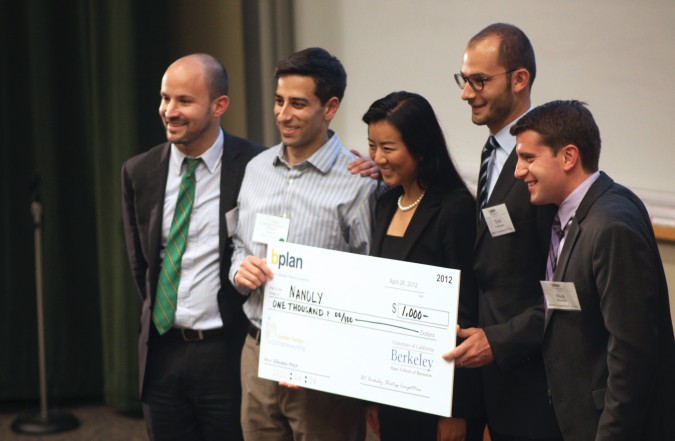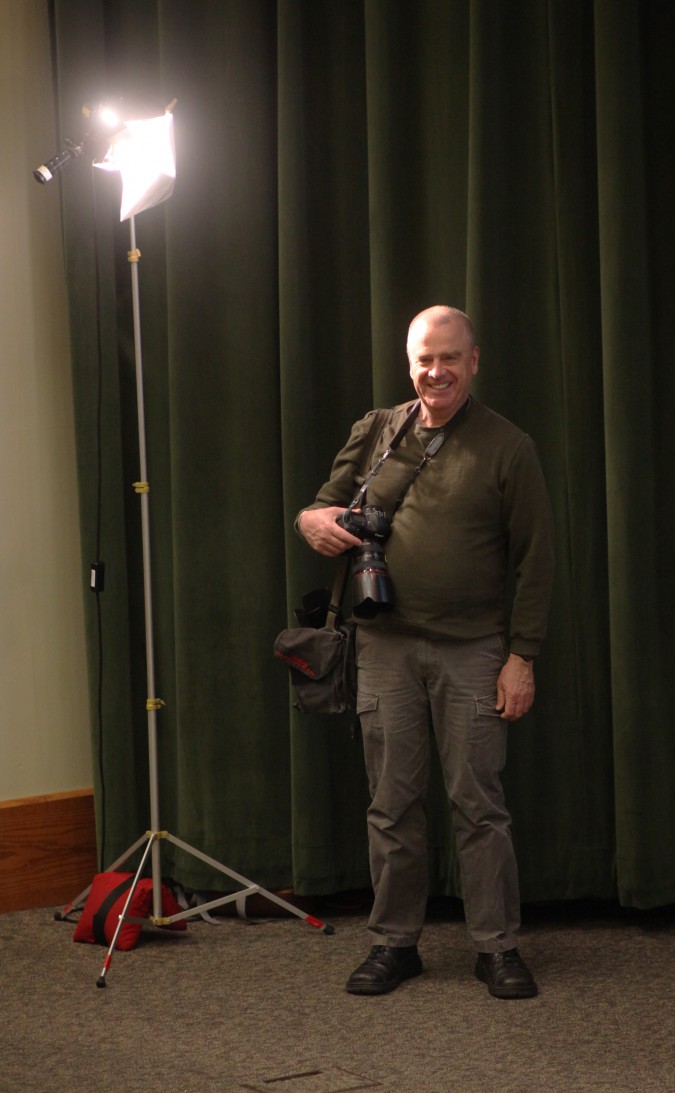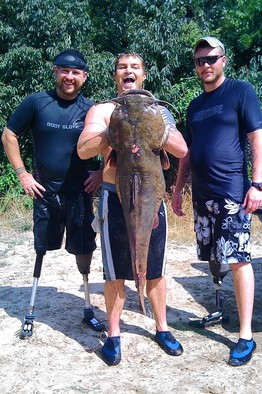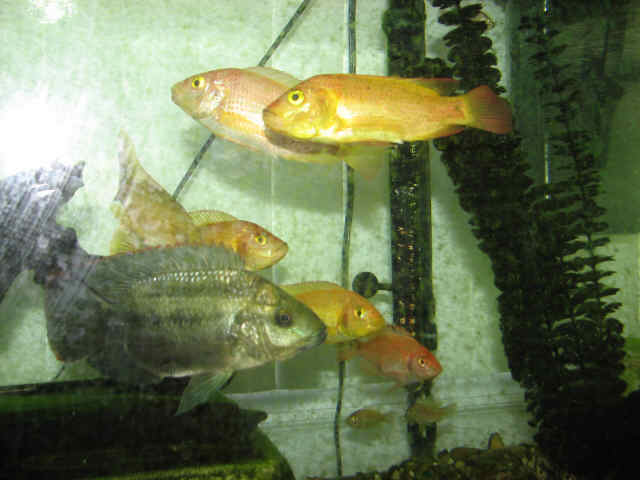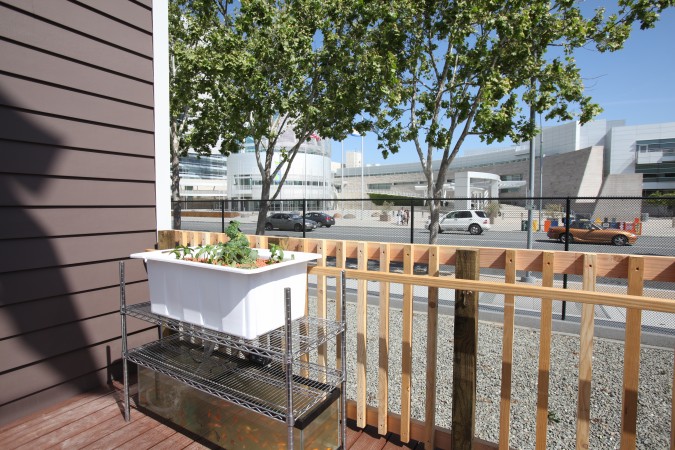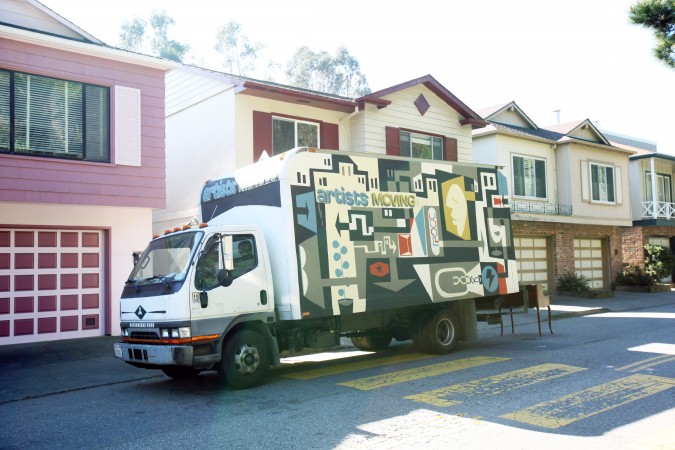Archive for the ‘aquaponics’ tag
2012 Berkeley Startup Competition Finals at University of California Berkeley
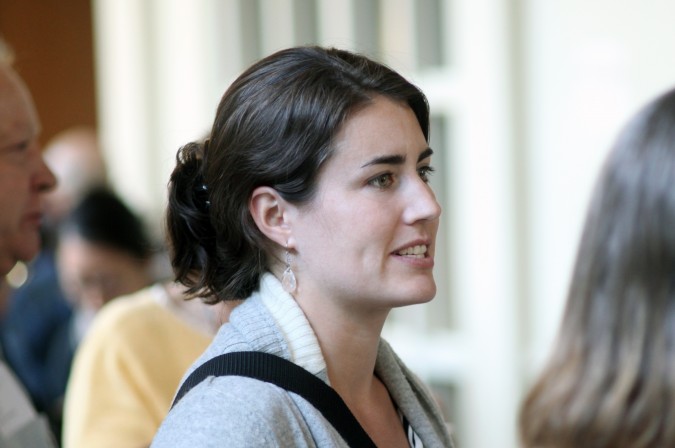
Kate Garrett, co-founder of Calcula Technologies, Grand Prize winner of the 2012 Berkeley Startup Competition, April 26, 2012
On Thursday, April 26, 2012, I attended the Berkeley Startup Competition Final Awards Ceremony at the Anderson Auditorium on the campus of The Haas School of Business at the University of California at Berkeley. Here is the PDF format file of the 2012 Berkeley Startup Competition Final Awards Ceremony program booklet that was handed out at the final awards ceremony.
There are many people mentioned in the booklet, like the Co-Chairs for the 2012 competition, Nick Nascioli, Adam Sterling and Tom VanLangen, as well as Lester Center Executive Director Andre Marquis and Haas School of Business Dean Richard Lyons.

Grand Prize winner Calcula Technologies at the Berkeley Startup Competition, April 26, 2012. Left to right: Nick Mascioli (co-chair of the Competition), Adam Sterling (co-chair of the Competition), Kate Garrett, Dan Azagury, David Gal, Buzz Bonneau, Tom VanLangen (co-chair of the Competition)
I most recently wrote about the announcement of the finalists for this competition, which happened two days earlier, on April 24, 2012.
Calcula Technologies won the Grand Prize and the Life Sciences Track for their clever system that vacuums kidney stones out of a patient’s urethra in just ten seconds. According to the team’s presentation, doctors today let stones pass from the body naturally and often quite painfully unless they are larger than 10mm in diameter. Patients today are often in such agony that they visit the emergency room, which racks up hundreds of millions of dollars in charges per year. For the sub 10mm stones, doctors just write prescriptions for narcotic pain killers and send the patients home with the stones still on their excruciating slow path out.
In the future, when and if Calcula gets their system approved by regulators, patients could have a catheter inserted into their urethra and the stone could be sucked out in seconds, presumably at great relief to the patient. This work could be done at the office of a urologist, without surgery, and the Calcula team said there is already a prized and lucrative reimbursement code in existence in the insurance industry, so if they build this system, they will be able to get paid and make a profit. I can understand why Calcula Technologies won the grand prize. Kidney stones are no fun, I’ve heard, and this system seems very appealing. The team showed a video of a fake kidney stone being sucked out of a pig’s urethra in just 10 seconds. It was very impressive and very memorable.
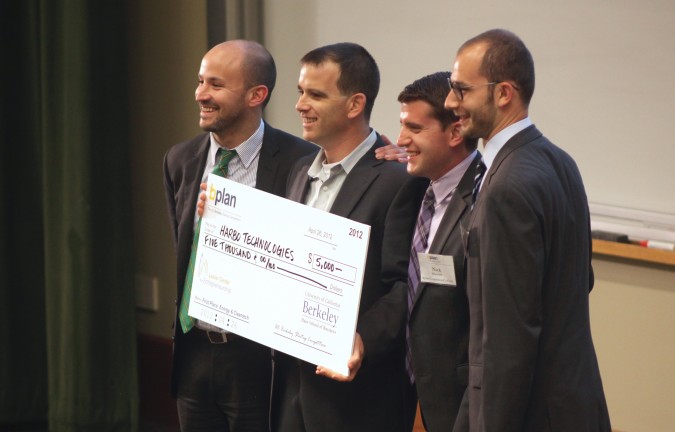
First Place Energy and Cleantech winner Harbo Technologies at the Berkeley Startup Competition, April 26, 2012
Kloudless, Inc. won first place in the Information Technologies and Web Track. I am going to be interviewing Kloudless, so I’ll save my remarks for another blog post.
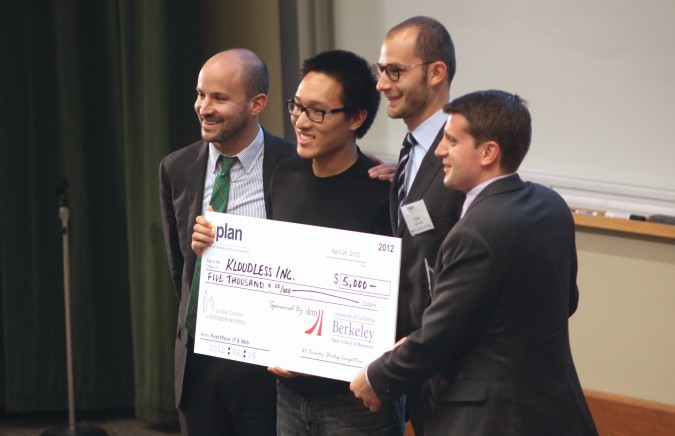
First place IT and Web Track winner Kloudless, Inc. at the Berkeley Startup Competition, April 26, 2012
Like Calcula, Back to the Roots (2935 Adeline Street, Oakland California 94608 USA) won two awards. First, they won the Products and Services Track, and then, thanks to real time votes from the audience and viewers of a live stream on the Internet, they won the Peoples’ Choice Award.
I have written about Back to the Roots twice before.
I have one of their products at my house right now. It works.
Back to the Roots collects used coffee grounds from coffee houses like Peet’s Coffee and mixes it with a ‘secret sauce.’ The combination is boxed up and sold at over 1,000 stores in the United States, including at Home Depot and Whole Foods Market. A consumer buys the cardboard box and partly opens it, exposing the insides. The consumer then mists the contents of the box with water using an included spray bottle. After ten days of twice daily misting, the consumer harvests a bountiful crop of oyster mushrooms that have grown directly out of the side of the box. Once one side has been used up, the consumer opens the other side to repeat the growing cycle for a second harvest.
That story has been told thousands of times, including on the CBS Evening News, an influential national newscast in the United States.
During their public presentation, the Back to the Roots team disclosed future plans that I find fascinating. Since this event was public and was streamed live to the Internet, I feel that it’s OK to write about what I learned, as there were no statements that anything said was to be considered secret.
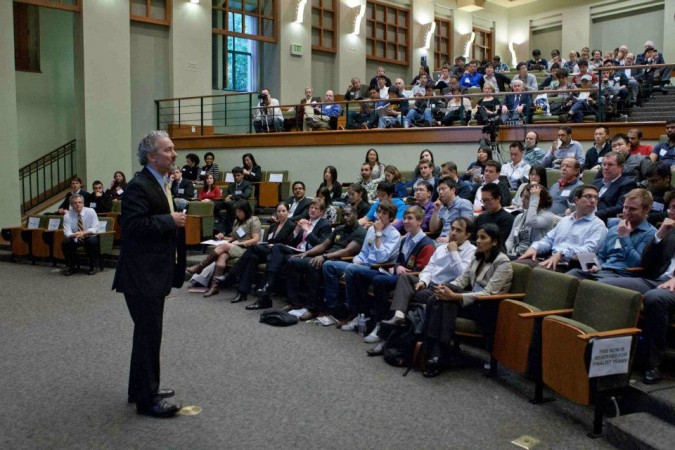
Haas School of Business Dean Richard Lyons speaks at the Berkeley Startup Competition Finals, April 26, 2012. Photograph by Bruce Cook.
The box contents will soon include vegetable plant seeds, and the rest of the box and liner will be biodegradable. Currently, the box is lined with what looks like conventional plastic. My box is from November, 2011, so things today may be different. In the future, or perhaps even already, the box will be lined with either nothing or something else that’s biodegradable. Perhaps what looks like conventional plastic to me is really biodegradable plastic, like some plastic trash bags are made of.

Venture capitalist Michael Berolzheimer, of Bee Partners, attends the Berkeley Startup Competition, April 26, 2012. Berolzheimer also leads the Haas Founders group that I am a member of.
Why do this?
Once the box is biodegradable and contains vegetable seeds, that means that after the two mushroom harvests the box can be planted in dirt for ’round three’ of production — vegetables. The mushrooms came from the waste stream from coffee houses. The round three vegetable garden will come from the waste stream of the mushroom garden.
This is beautiful.
What’s coming down the road from Back to the Roots?
I am overjoyed to report the answer may be affordable aquaponics kits.

Kevin Esse at networking hour prior to attending Berkeley Startup Competition Finals, April 26, 2012
I have written before about my love for aquaponics.
Aquaponics is food production gardening enhanced by growing edible fish in symbiosis with vegetable plants. Both parts of the system are made more productive by the presence of the other half. Fish poop gets converted by bacteria into rich fertilizer. The fish grow faster because the plants keep the fish tank cleaner. It’s a great growing system that I feel should take over the world on such a scale that every person has their own system at home.
I am too busy in life to advance this dream, but the team at Back to the Roots has time and energy and market traction, so I think they would be ideal to push aquaponics to a large audience. I am so excited about this that I have already offered to tell the company everything I know about aquaponics free of charge to encourage them to get this to market.
I suspect they plan to start with small, under USD $100 demonstration kits. This in my mind is the way to start.
I bought my startup supplies for my aquaponics system from The Aquaponics Source. This online retailer sells complete systems, but the price is too high for people to buy casually, at over USD $1,000. I believe a profitable sub $100 kit could be sold, as what’s required is similar to what’s inside a Mr. Coffee brand coffee maker — two water containers, a pump, a heater and some electronics to coordinate the steps. I can get a nice computerized Mr. Coffee coffee maker for about USD $25 from Amazon, so even in the smaller quantities a demonstration aquaponics system would sell in initially, I think it can be done.
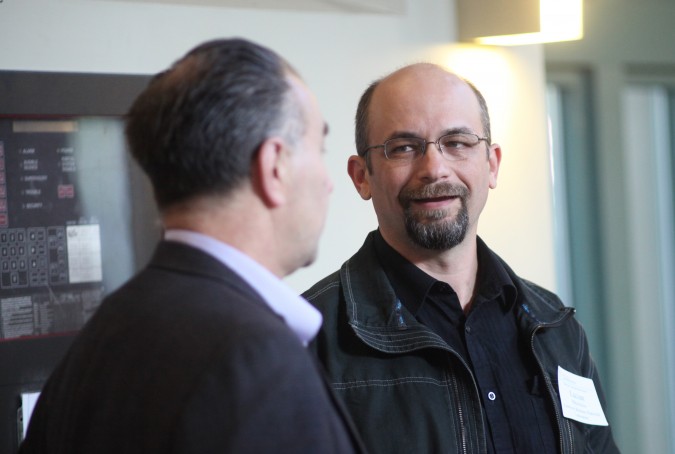
Lucian Mihailescu of Lawrence Berkeley National Laboratory attends the Berkeley Startup Competition, April 26, 2012
I love advising startup companies, and I would particularly like to advise about aquaponics, even though I know relatively little about the subject, since I’ve only built one demonstration system so far. My system was a modest success for I grew the largest and sweetest tomatoes I have ever eaten.
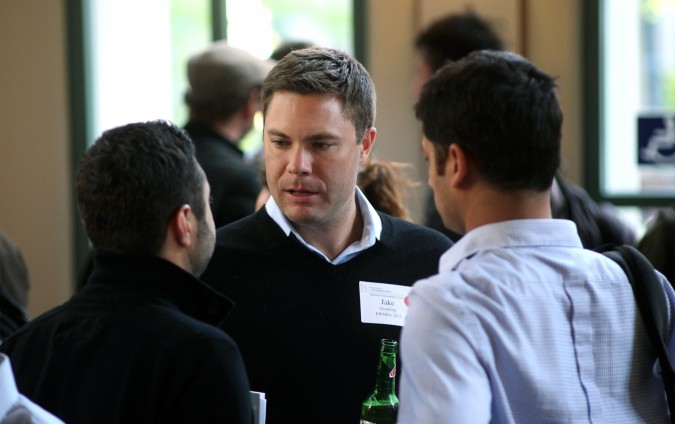
Jake Gentling at the networking hour prior to attending the Berkeley Startup Competition Finals, April 26, 2012
HARBO Technologies won First Place in the Energy and Cleantech track. I introduced myself to co-founder Boaz Ur and mentor John Matthesen after the conclusion of the event. The company is working on something I find impressive and interesting. I have made arrangements to interview the team, so I will hold my remarks until after that interview.
My friends at Modify Industries took home a USD $1,000 prize for coming in second place in the Products and Services Track. This outcome was inevitable, and I predicted it accurately the moment I saw Modify was competing with Back to the Roots. Back to the Roots simply has had much more commercial success so far. While Modify has sold between 10,000 and 100,000 watches to such companies as Google and Hewlett Packard, they haven’t yet cracked the retail store market, and they haven’t been on the evening television news. It’s rare for a company to be so far along like Back to the Roots, but still be eligible to compete in the Berkeley Startup Competition. In all other years where there was a Products and Services Track, Modify probably would have won that track. I pay attention to these things because I was a judge for this competition for the eight years through 2011. This year I mentored the team University Gateway, which did not make it to the finals since Modify and Back to the Roots filled up the Products and Services Track.
Modify gave an impressive and bold presentation, where they outlined a dream for their enterprise far bigger than time pieces. They probably adjusted their pitch to compete with Back to the Roots. But they forgot to show their product in action amid all the grand dream spinning. How so? They forgot to personally show the audience how to change a watch element from one silicone strap to another. This is worth showing at every pitch for it’s compelling and like nothing I’ve seen in the watch business. No tools, no training — 10 seconds and you have an all new look.
Finally, I want to give some space to my friend and fellow photographer Bruce Cook. I’ve known Cook since nearly the inception of The Lester Center for Entrepreneurship & Innovation. He’s a fixture at all sizable Lester Center events. He has his own photography business, Bruce Cook Photography, and is not a University of California employee. I can’t recall there ever being a different photographer for a Lester Center event. The picture above is of Cook standing under the video light in Anderson Auditorium. The picture below is of Cook taking a picture during the networking hour in the Bank of America Forum, the large gathering area just outside of the Anderson Auditorium. Cook took the picture above of Dean Lyons speaking to the audience. Thank you Bruce!
If The Lester Center is reading this, may I suggest that you contact Cook and work out a deal where his vast library of photographs of Lester Center events over the last twenty years can find a permanent home on the Lester Center website and in the University library system. Cook has photographed some of the most important figures of our time, and the tremendous majority, over 99%, of his photographs have not been published. I think these photographs should also be published on Facebook so that it’s easy to crowd source the identification of the people in the pictures, via the Facebook tagging system. Once the faces are tagged, then the captions on the Lester Center website can be updated to reflect the identities of those pictured.
Why do this?
The Lester Center and its events are documenting history. It’s that simple. Bruce Cook has a treasure trove of historic pictures that few have ever seen.
As an added bonus, publishing and captioning Cook’s 100,000+ pictures will boost traffic to The Lester Center’s website, as people search on Google and similar sites for the many luminaries Cook has photographed. The search engine optimization benefits to posting these pictures will probably overshadow every other single project you could undertake.
This is my idea alone.
Cook did not plant this, suggest this or hint at this.
I’ve been thinking about this for years now, and here seems like a fine place to promote the idea.
I believe I have shared this suggestion with Jerry Engel when he was Executive Director of The Lester Center, but that was only in passing at a hectic Berkeley Entrepreneurs Forum, not a written proposal such as this one.
Please consider this official advice, and let me know when I can blog about the happy news. Thank you.
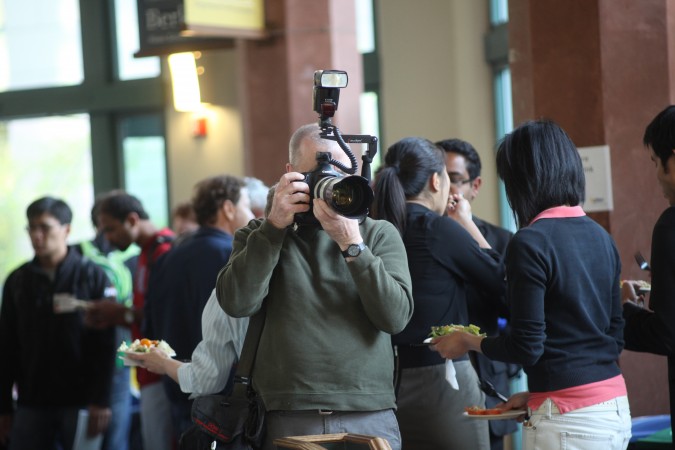
Bruce Cook, the photographer for The Lester Center events, covers the Berkeley Startup Competition, April 26, 2012
I introduced myself to all the finalist teams except AdrenaRX. I believe the members from that team departed before I had a chance to find them.
I offered each of the eight finalist teams except for Modify and Back to the Roots the opportunity to be interviewed by me for a future blog entry. Two of the teams have contacted me to schedule an interview. Four teams have not yet contacted me.
I know the Modify and Back to the Roots founders, so I did not offer to interview them. This was not meant as a snub — I simply forgot to offer in my excitement of congratulating them. Both teams are doing so well they don’t need my blog coverage, but if they would like more in depth stories, I am happy to meet with them. Just send me a message. I am on Facebook and easy to reach. I have turned on the ‘subscribe’ feature, so everyone reading this is invited to subscribe to me on Facebook. You may also sign up with your email address to receive updates to this blog, in the upper right corner of this page.
All the pictures I presented above except for the one by Bruce Cook are also on my Facebook page in this album. If you know these people, particularly the people in the shots with the giant checks, please tag them on Facebook so I can update the captions here with the names. All my pictures on Facebook are public, so if you tag someone there, I consider those names to be public, and on that basis I will update the captions here.
The sponsors for the 2012 Berkeley Startup Competition include:
Gold level:
Claremont Creek Ventures
DCM
UM
Silver level:
Javelin Venture Partners
Lowenstein Sandler
Mintz Levin
Mohr Davidow
Morgan Stanley
Morgenthaler Ventures
Morrison & Foerster LLP
Wilson Sonsini Goodrich & Rosati PC
Individual level:
There were possibly other individual sponsors. No individual level sponsors were listed in official materials this year, a departure from past years.
The Executive Committee for the 2012 Berkeley Startup Competition:
Co-Chairs
Nick Mascioli
Adam Sterling
Tom VanLangen
Judging & Sponsorship
Robbie Allan
Jane Buescher
Vivien Leong
Larry Pier
Marketing & Events
Stephanie Knoch
Krishna Shah
Mentorship & Events
Amara Aigbedion
Hrishikesh Desai
Program Manager
Kirsten Berzon
Noodling = capturing catfish in the wild by hand or feet
The Wall Street Journal has gone downhill since it was acquired by News Corporation.
Even so, I still read it.
I feel guilty about it, but I loved the paper for so long it’s hard to stop reading it.
One of the things I love about the paper is it prints some crazy stories. This is not a News Corp. addition — the Wall Street Journal has published crazy stories for decades.
One of my favorite crazy Wall Street Journal articles was published about 20 years ago. The article spoke about how rat is served in Southern China in restaurants that specialize in serving just rat based dishes. The writing was so colorful and visceral I remember it well even today. Apparently rat causes nosebleeds for some diners. According to the story, eating rat can make you feel warm and perspire so much that you are inclined to take off your shirt in the restaurant, as some diners did in front of the Journal reporter.
The image of a group of bare chested men eating rat with blood running from their noses is hard to forget.
When I was in Wuhan, China in 2005 for the TeX Users Group International Typesetting Conference I asked the locals if there were any rat serving restaurants in the city. I was told no, that I would have to go further south for that. The article said the restaurant grade rats are raised using a free range technique on dedicated pasture surrounded by electric fencing. The article made it sound like the rats are fed well and are healthy and clean. I would try them. I want to try them. Hmmm, maybe I could buy some lab rats and try to cook them at home? What would my 4 roommates would say about that?
On May 16, 2011 the Wall Street Journal published a story that nearly is as captivating as the rat story — Long Arm of the Law Penalizes Texans Who Nab Catfish by Hand.
There is a way to fish for catfish called noodling. Here’s a description from the article:
Techniques vary. When the fisherman puts his hand into the hole where the fish is, the fish usually bites. Then he can grab the catfish by a lower-jaw bone, or, if he sticks his arm in deep enough into the fish’s body, he can poke his fingers through its gills.
But most important is controlling the tail, Mr. Webb says, which is usually done by the noodler wrapping his or her legs around the fish. “If you don’t get that tail immobilized, I don’t care how big or strong you are, you’re not going to whip that fish,” he says.
For extra reach, some practitioners stick their legs instead of their arms into dark underwater holes. Apparently, you can lose a leg noodling, judging from the shocking photograph accompanying the article, shown here, which shows three men. One has two legs, one has one leg and one has zero legs. They just caught a 60 pound catfish some 5 feet long, and they’re smiling widely.
I knew I would write about this story as soon as I read it. What I didn’t know at the time of publication was that I was soon going to be raising catfish in my backyard in San Francisco, California, USA.
I placed my aquaponics fish tank in my new Harbor Freight greenhouse last week, and I have catfish swimming in the fish tank. Don’t worry, they’re small enough I won’t lose my arms or legs anytime soon.
I have pan fried four catfish in recent weeks, and I like catfish more than Tilapia. I find catfish has more flavor than Tilapia. I am having trouble keeping the catfish alive, which is why I’ve been eating so much catfish recently. But I have read they are almost as easy to raise as Tilapia. I fear I am doing something wrong. I will figure it out and make a success of my catfish project.
Catfish is harder to prepare because you have to pull off the raw skin with large shop pliers, which is a physical chore and messy. But I’m getting better at it, and after ten more fish I predict I’ll be able to remove the skin in under a minute.
A while back I bought a used 275 gallon IBC tote for USD $120 that I plan to cut the top off of. I will then use this food grade tote as a monster fish tank. I should be able to raise 100 to 200 catfish at a time in this tank, which will give me so much fish I should be able to eat a full fish every two days or so, without depleting the stock. I have read that catfish are so efficient that they convert 2 pounds of feed into 1 pound of fish. The feed can be mostly worms you grow yourself using kitchen scraps as feed.
Tilapia in San Francisco?
I am finding it difficult to learn for certain if I may raise Tilapia fish in my aquaponics system in my backyard in San Francisco, California.
The California Department of Fish and Game website is not helpful, because it doesn’t appear to address aquaponics, where the fish are kept in an enclosed aquarium, not in a pond, wetland, river, lake or ocean.
I have found websites that suggest I may raise Tilapia anywhere in California provided I select the correct type of Tilapia. One such website, Tilapia farming at home is clear on this subject, but even so, I want to be sure I comply with the law.
Governments can hand out severe punishments for raising Tilapia where not allowed. I watched a DVD about aquaponics in Australia, and the fine for having a dead or alive Tilapia fish in the wrong part of Australia is over $100,000 Australian dollars!
Greenerati.com writes about my aquaponics system at PCBC
Blogger, writer and consultant Keith Rockmael wrote the post Aquaponics Outside PCBC and West Coast Green about my aquaponics system that’s been on display this week at PCBC in front of Moscone Center in San Francisco, California USA.
Here’s a screen capture of just the first part of the post… please be sure to click on this link to send him some traffic.
The house in the background is by New Avenue, Inc.
Moscone North is to the immediate left, as this house is sitting in the driveway in front.
New Avenue personnel staffing the New Avenue eco house told me that representatives from three other trade shows asked about getting an aquaponics display for their shows. If these trade show representatives are reading this post, I am interested in helping out, even though I am not in the aquaponics business.
I’m a software entrepreneur that’s simply fascinated by aquaponics.
I built my first aquaponics system – you’ll never guess where it is
I’ve written about my friend Kevin Casey a few times before (January 7, 2011, January 9, 2011 and January 11, 2011). I met him in 2007 when he was one of the student organizers for the University of California Berkeley Business Plan Competition. I was a judge and financial sponsor for that competition, so we had plenty of opportunities to talk. We became friends on Facebook, and when he started posting status updates about his startup New Avenue, Inc., I got back in touch with him.
Kevin staged the ribbon cutting for his first house on January 8th, 2011. Soon after, the city of San Jose, California contacted Kevin and asked that he construct a custom house for a 9 month exhibit of green technologies called the San Jose Green Vision Clean Energy Showcase. This exhibit opened this month, in May, 2011. The location is directly across the street from the sparkling City Hall of San Jose.
Here’s the PDF brochure that San Jose is distributing about its Clean Energy Showcase.
Ever since I contacted Kevin in late 2010, I have been talking his ear off about my ideas for shipping container based green housing. One of the parts to my grand plans is to make it practical for residents to grow food at home. The most exciting and productive way to grow food in limited space with limited water is to raise fish and vegetables in symbiotic harmony. This technique is widely known by the word ‘aquaponics.’
Kevin approached me and asked if I’d like to set up a small demonstration aquaponics system on the front porch of his New Avenue demo green home. I jumped at the chance, as this gives me a great excuse to learn more about this and help a friend at the same time. Aquaponics is really popular in Australia, which is in the midst of an 11 year draught. Aquaponics systems use 1/10th the water required to grow vegetables in dirt. Since the world is ‘running out’ of fresh water, it makes sense to learn more about a system that makes such efficient use of water.
I put together a system with off the shelf parts I selected and modified personally. The result doesn’t look bad, but doesn’t look like a commercial polished product either. I am happy with the result for my first system. I used a wire shelf rack from Costco as the frame. I was concerned that infants could drown in a system that didn’t fully cover the water tank, so by setting the height of the first shelf to just over the height of the water tank, I eliminated that risk. You can see this safety feature in the picture above.
The water aerator and the timer are located in an exterior grade water resistant steel junction box fastened to the rear shelf. From there, the system is connected to a GFCI outdoor outlet on the rear of the house. While you can’t see it in the picture because I hadn’t installed it yet, the fish are fed automatically each day via a timed automatic fish feeder.
The vegetable bed is flooded with a foot of water from the fish tank 24 times a day. The flood/drain cycle takes about 18 minutes, and starts on the top of each hour. The pump consumes just 18 watts during a 15 minute per hour fill cycle. The extra 3 minutes is the time it takes for the growing bed to drain back into the fish tank.
The vegetable roots cleanse the water. Since the vegetables get all the water they can absorb, they grow faster than in dirt, up to 600% faster. The fish also grow faster than normal because they get so much clean and well aerated water. It’s a true win/win scenario. The main inputs are fish food and water to replace what is lost to transpiration and evaporation. On occasion, there are tiny inputs of a teaspoon or so of fluid to adjust the pH to keep everything happy. I understand that this is needed primarily during the first 6 weeks of operation, before the healthy bacteria have established themselves in the clay beads that the plants grow in.
I am no expert, but I’m learning a lot, and I appreciate the opportunity to learn on such a public stage. I’ve already met two people that have seen my system and want one of their own!
To learn more, read Backyard Aquaponics Magazine.
Special thanks to Sylvia Berstein, Founder and CEO of The Aquaponic Source, who helped me set up my first system and sold me some of the key parts. Her store is located in Boulder, Colorado, USA.
My new roommates moved in today
Today my new roommates moved into my house in San Francisco. The picture shows the colorful ‘artists moving’ truck one of my new roommates hired off Craigslist.
It took me two months of work to rent out my three spare bedrooms. I am beginning a grand adventure in sustainable urban homesteading in the heart of San Francisco, and I believe I have found four outstanding individuals to share in this quest.
I rented the master bedroom to a married couple. The husband is a graduate student at San Francisco State University and the wife is completing her residency at a local hospital.
I rented one of the guest bedrooms to a small business owner, and the other guest bedroom to an undergraduate student at San Francisco City College. There are now 3 women and 2 men living here.
All four roommates have a strong interest in growing and raising food. We are planning to cook dinners together two nights a week, which I think will improve all of our cooking skills. I specialize in Chinese and Indian cooking, so I am eager to learn more about preparing other cuisines. Already one of my new roommates has revealed her extensive cook book collection, which she will store in the living room alongside my extensive cookbook collection. I am thrilled because I love cookbooks.
Each rented room has a pet. The house now has 1 cat and 2 dogs. One dog is a Cattle Dog and the other is a Great Dane! I never dreamed I would agree to have a Great Dane live in my house, but this is the nicest large dog I have ever known, and so calm and sweet. I liked the couple, and was particularly happy the husband is studying the molecular biology of fish in graduate school, so he knows vast amounts more about fish than I do. Since the center point for the garden is going to be an aquaponics system, I thought he brought a valuable skill to the table. He also once tried to convert a bus into a motorhome, but had to abandon the project when it got to be too difficult. It was just too perfect to run into a fellow busnut who knows and loves fish, so I had to say yes to the Great Dane. But from what I’ve seen of the great dane so far, she’s very lovable and sweet, and I genuinely look forward to having her here in my home.
The cat and other dog are lovely as well.
I spent today cleaning out the refrigerator and the kitchen cabinets, as I had taken over all the available space during the few months I had the whole house to myself. It was lonely here during that time, and I am really happy to have people living here again. For those who have not heard the sad news, I have decided to divorce my wife, and I have had a process server serve her a lawsuit summons and a divorce petition. We separated on October 25th, 2010, and not long thereafter our roommates Kim and Denise moved out. They were close to my wife, and it made for an awkward situation to continue to have them here. Thankfully, they each decided on their own to find new accommodations. I enjoyed having them as roommates, and I wish them all the best. I loved Denise’s dog Abigail, the nicest dog I have ever known.
I once loved my wife with all my heart, and she was once the most important person in my life. It’s sad that part of my life has passed.
Today is an exciting day with all the moving activity. I am planning to post dozens of blog entries this year about our urban homestead, so please subscribe to this blog if want to learn what happens. If you have experience with aquaponics or urban homesteading, please leave me a comment.
